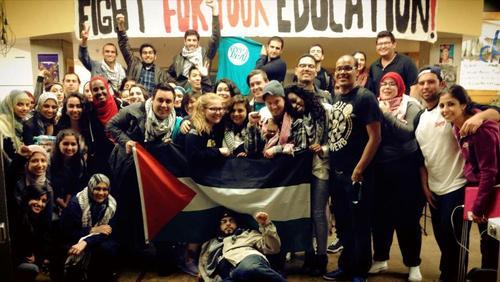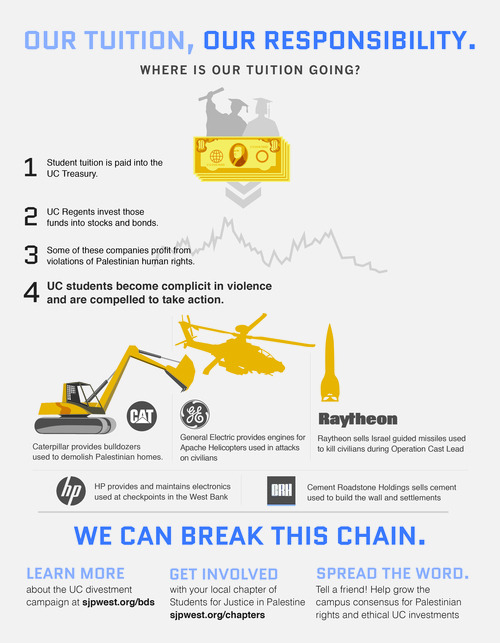 UC San Diego activists celebrate the passage of a divestment resolution on March 15, 2013, after a four year campaign. – Photo by Huma Waseem
UC San Diego activists celebrate the passage of a divestment resolution on March 15, 2013, after a four year campaign. – Photo by Huma Waseem
Students for Justice in Palestine: Building a Movement from the Ground Up
By Sean Estelle
The third annual Students for Justice in Palestine National Conference on October 25-27 continued the trend of growth in the Palestinian solidarity movement on college campuses across the United States. The theme of the conference was “From Margin to Center: Connecting Struggles, Forging a National Movement,” and what better way to connect struggles and celebrate victories – like successful divestment campaigns across California or new SJP chapters opening nationwide – than talking about building blocks and foundational work?
What is SJP?
SJP, or Students for Justice in Palestine, is a name taken by many student-driven organizations across the United states working to achieve justice in Palestine that goes on – both within historical Palestine (all the land known today as Israel and the Occupied Palestinian Territories) and for the more than five million Palestinian refugees living throughout the world.
How does SJP work towards achieving justice in Palestine?
Each SJP chapter works differently, based on what the members within their specific campus organization feel to be appropriate measures of solidarity in their specific location. Until recently, SJPs were mostly autonomous; now, because of the National SJP conferences, more regional networks have formed and started to coordinate on campaigns (like SJP West’s divestment campaign across seven UC campuses this past academic year). Most long-term campaigns work within the Boycott, Divestment, Sanctions framework, since that is what the Palestinian people have called for as a tangible form of international solidarity.
What is the BDS framework?
This three-pronged approach targets both economic and social capital within a country that is actively oppressing its inhabitants. First popularized during the struggle against South African apartheid (University of California students played a key role in advancing American divestment campaigns then as well), various BDS tactics have also been used by everyone from civil rights activists to the U.S. government.
- Boycotts are forms of withholding goods or services by choosing what to purchase, on a consumer level, and choosing who to have professional relationships with, on an institutional level. This can look like refusing to use Ahava beauty products, or any other product explicitly manufactured in the Occupied Territories. Oftentimes the boycott is broken down into academic, cultural, and consumer boycotts, as they all have different concerns and tactics attached to each.
- Divestment means looking at the financial holdings of an institution such as a church or a university, seeing if they are invested in any companies with clear ties to institutions participating in the Occupation (such as Caterpillar, HP, or Northrup Grumman), and asking the institution to disinvest, or divest, from them.
- Sanctions are the dissolution of ties – whether military, economic, or diplomatic – between nation-states. This is more of a long-term strategy, especially in the United States: our government currently has taken the opposite path by pledging 30 billion dollars in military aid to Israel in the next decade.
So what would an SJP-based BDS campaign look like?
I’ll let an infographic explain:

At the University of California, we face a Board of Regents that has said they will only divest “when the United States government declares that a foreign government is committing acts of genocide.” As the U.S. probably won’t be declaring that about the government of Israel (regardless of its thorny past) any time soon, UC activists face a tough fight.
In 2012-2013, seven resolutions were brought before student governments at the UC (and Stanford) calling for divestment from companies complicit in Israeli Defense Forces’ human rights abuses. Four of the resolutions were passed (although one was later rescinded), and there was a huge shift in discourse around Palestine Solidarity work in California.
Do SJP groups ever face repression for the sort of work they do?
Absolutely. Aside from the personal threats often lobbied at SJP activists, institutional repression can be extremely harsh – like the letter from New York City Council Assistant Majority Leader to the president of Brooklyn College threatening to defund the entire school if one department continued to sponsor a BDS panel discussion. In 2010, when a divestment bill was introduced in UC Berkeley’s student senate, there was a massive, vicious campaign to pressure individual students to change their votes (e.g. through letters from Nobel Laureates).
What about other work besides BDS?
There’s a lot of other work that goes on besides BDS campaigns. Because SJPs are acting in solidarity with an oppressed people, there is often a need to have activists that are aware of the situation on the ground in Palestine; if there is an extrajudicial killing, or an unfair house demolition, or a full-scale military operation, SJP activists can quickly organize candle-light vigils or emergency rallies. However, many SJP groups often work in collaboration with other groups on campus; because of SJP’s structure, most chapters end up taking part in other actions happening on their respective campuses as well.
Why is SJP so important, and how can I get involved?
Today, MSNBC released an article detailing the new round of cuts to food-stamp programs that took effect Friday. Meanwhile, the U.S. has given over 130 billion dollars to the state of Israel, and millions more are being given every year. The Palestinian people are forced to deal with undemocratically elected leadership that signs away the land of its people for breadcrumbs. And yet, the movement for international solidarity is growing. More and more people are respecting the call to boycott, divest and sanction, and this is starting to create a major shift in public opinion around the idea of BDS.
Ask around and see if you can find a meeting time for your local SJP chapter. If there is no SJP on your campus, here are a list of resources and good websites to check out: sjpnational.org, endtheoccupation.org, jewishvoiceforpeace.org/toolkit, electronicintifada.net, mondoweiss.net and visualizingpalestine.org.
Time to organize!

